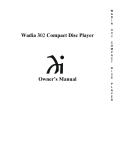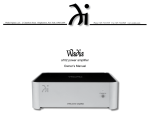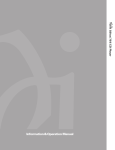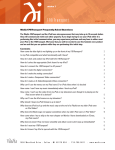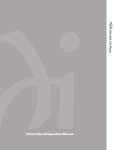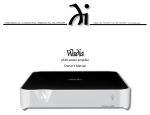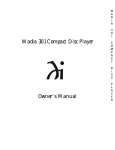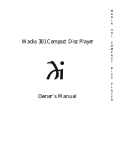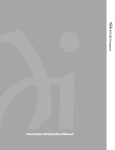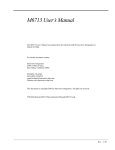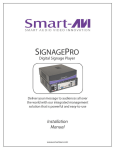Download Wadia 170iTransport
Transcript
manual 170iTransport with Universal Dock for iPod Thank You. All of us at Wadia Digital would like to say thank you, and congratulations for purchasing the Wadia 170iTransport Digital iPod integration device. We sincerely believe that your Wadia 170iTransport is an intelligent investment that will bring you many years of musical enjoyment and satisfaction. We understand how eager you are to begin listening and we want you to become familiar with the full capabilities of the Wadia 170iTransport. However, before powering on the device, we encourage you to look through the manual and pay special attention to the sections highlighted with an ◆. Table of Contents Installation Connections Wadia Digital – a Brief History Advantages of Digital Audio Optimizing Performance 4 6 7 Unpacking Accessories Installing Battery in Remote Control ◆Connecting to AC Power ◆Installing iPod Dock Inserts 8 8 9 9 9 Choosing a Digital Cable 10 ◆Connecting to an Audio or Audio Video System 11 Operation Supported iPod Models ◆Connecting the iPod iPod Functionality Using the Remote Control Using Analog Audio Outputs 14 15 16 18 20 Appendices Environmental Care Important Safety Precautions Trouble Shooting Warranty Specifications 20 21 22 23 24 Wadia Digital – a Brief History Wadia Digital, founded in 1988, is one of the original companies dedicated to high performance digital audio reproduction. Wadia was formed by a team of engineers from the Minneapolis based 3M Corporation (Minnesota Mining and Manufacturing) who shared many years of experience in advanced digital telecommunications research and development. In the early 1980’s, these engineers became intrigued by the emerging compact disc technology. Disappointed with the sound quality of early CD players, they examined the workings and designs of these early components and found them to be unsophisticated when compared with the technology available in other areas of digital design. In response, they founded Wadia Digital – a company based on the philosophy of applying advanced technology to improve the performance of digital audio components. Wadia’s first product, the Wadia 2000 Decoding Computer, was an absolute breakthrough in digital audio. For many discerning listeners, it proved that Digital Audio was a musically responsive, evolving, and engaging format. Building on a tradition of excellence, Wadia continues to develop innovative technology; refining, listening, engineering, and improving along the way. Since the Wadia 2000, new generations of industry-leading designs have been introduced and embraced by listeners around the world. Each step of the way, Wadia has consistently raised the standard for performance of Digital Audio playback. 4 Here is a brief list of the technological innovations the Wadia engineers have pioneered over the past 20 years: • DigiMaster™ patented algorithm (filter optimized for reproducing music) • ClockLink™ proprietary jitter reduction technology • SwiftCurrent™ current to voltage conversion technology • First outboard Digital-to-Analog converter • First to apply glass fiber-optics to home audio • First to recognize jitter as a source of audible distortion • First to perfect digital volume control • First high-end CD player competitive with expensive separates • First company to provide bit perfect digital audio output from the iPod While Wadia’s expertise and track record exceed those of most digital audio companies, technology alone does not guarantee an immersive and captivating musical performance. Wadia’s intuitive designs are born of a delicate balance of technology shaped by a passion for music. Wadia continues to re-define the limits of digital music playback. We are proud to introduce the Wadia 170iTransport – a breakthrough in sonic performance and a strong statement of our dedication to music. 5 Advantages of Digital Audio Digital audio signals can be processed without the additive losses and distortion found in analog processing. This loss of resolution is caused by analog circuitry and connectors in a signal path. The 170iTransport bypasses the digital to analog conversion and analog output stage from the iPod. By providing a pure digital audio output from your iPod, the 170iTransport enables performance that is only limited by the resolution of the audio files stored on your iPod, and the overall quality of your audio system. In other words, the 170iTransport makes it possible to achieve true audiophile performance from your iPod. 6 Optimizing Preformance For optimum sonic performance when using iPod we highly recommend that you store music at the highest bit rate you can justify. Storing music files at higher bit rates will require substantially more storage space on your computer and iPod, however, the sonic improvement is self evident. The highest available quality is achieved by importing music into iTunes as WAV files. WAV files are full resolution files equal to the original master source. Another good option for storing music in iTunes is Apple Lossless. Apple Lossless will allow you to preserve much of the performance of your music while not using as much space on your computer and iPod. To make sure that you are importing music at the highest bit rate you will need to open iTunes and follow these instructions. • Select – Open the iTunes drop down menu (Mac), or Edit Tab (Windows) from the menu bar • Select – Preferences • Select – Advanced Tab (within the Preferences window) • Select – Importing Tab (within the Advanced Tab window) • Select – Import Using (2nd Selection From Top). With this Drop Down menu you will be able to select WAV or Apple Lossless • Select – WAV Encoder or Apple Lossless Encoder 7 Installation Unpacking Use care in unpacking your Wadia 170iTransport. Inspect it for any signs of shipping damage and call your dealer immediately if any is found. Do not plug your Wadia 170iTransport into any outlet if you find shipping damage. Please save all packing materials so unit can be easily and safely shipped if the need arises. Accessories Included in the carton, you will find an accessory kit that contains the following: • Locking AC Adapter and Power Cord • IR Remote Control • Digital Coax Cable • iPod Adapter Inserts Analog Audio/Video Cables are not included with the Wadia 170iTransport. For optimal performance, please contact your local dealer for information on Audio/Video Cables that will be most compatible with the Wadia 170iTransport and your system. 8 Installing Battery in Remote Control The Wadia 170iTransport remote control will ship with the required battery preinstalled. However, you will need to remove the clear plastic insert tab from the battery to allow operation of the remote. ◆Connecting to AC Power Check to make sure that the power cord shipped with your Wadia 170iTransport has been manufactured for operation at your AC line voltage. Damage caused by improper operation is not covered by Wadia warranty. If the included cable and wall termination is different from your AC outlet, contact your Wadia dealer. ◆Installing iPod Dock Inserts The Wadia 170iTransport comes with several dock inserts that will allow it to accommodate the compatible iPod models. First, you will want to determine which insert fits your iPod model. If there is already a dock insert in the Wadia 170iTransport, you will want to remove it. This is accomplished by applying slight pressure with your thumbs to the back of the insert while pushing up to release the dock insert. To install the new insert, make sure that the two (2) small slits in the inside of the insert are facing the front of the Wadia 170iTransport. Place the dock insert over the multi-pin metal connector and carefully click into place. 9 Connections Avoid static discharge to the inputs or outputs. To prevent static shocks, touch any grounded surface, such as the chassis of any component that uses a grounded 3-prong plug, before connecting or removing a cable. It is unlikely that a static discharge will damage the unit, but it may cause the Wadia 170iTransport circuitry to “lock-up” (see Lock-Up under Trouble Shooting in Appendices). Choosing a Digital Cable The Wadia 170iTransport uses a Coaxial S/PDIF Connection with an RCA connector. The quality of any of these transmission methods depends on the quality of the cable and the sophistication of the transmitter and receiver. While the cable included with the Wadia 170iTransport will certainly work for the transmission of digital information between the Wadia 170iTransport and a Digital to Analog Converter or other digital receiving device, we recognize distinct advantages in higher quality cables available today. Again, we highly recommend that you take advantage of your dealer’s experience and, most importantly, trust your ears. 10 ◆ Connecting to an Audio or Audio/Video System 1 2 3 4 5 Back Panel (from left to right) 1 Power: The power supply comes with the iTransport. It is a custom power supply and the use of any other power supply will void the iTransport warranty. 2 Digital Out: This is a digital audio output that is compatible with the S/PDIF standard. It is intended to mate to a coax digital input on a compatible device. 3 Analog Audio: Left and right analog outputs from the iPod. The analog audio outputs are not active simultaneously with digital audio output. 4 S-Video / Composite Video: For the older generation of video capable iPods (such as iPod video) this connection will supply the video output from the attached iPod. The iPod must not be in the “extended interface” mode (see mode key). 5 Component Video: This is the high resolution video output available from the newer generation of iPods (iPod touch, iPod classic and iPod nano 3G). 11 Making a Digital Connection Connect your chosen cable from the S/PDIF Coaxial Digital Audio output on the Wadia 170iTransport (connection 2 in iTransport Outputs illustration) to the corresponding digital input on your Digital to Analog Convertor, Digital A/V Receiver or Digital Preamp/Processor. Making an Analog Connection Connect your chosen cable from the Left and Right Line Level Audio outputs on the Wadia 170iTransport (connection 3 in iTransport Outputs illustration) to the corresponding analog input on your Television, Stereo Receiver or Other Analog Input Device. Making an S-Video / Composite Video Connection Connect your chosen cable from the S-Video output on the Wadia 170iTransport (connection 4 in iTransport Outputs illustration) to the corresponding S-Video input on your Television, A/V Receiver or Preamp Processor. For Composite Video Display output, you will need to purchase an S-Video to Composite Video Adapter cable. Please contact your local dealer for more information on this type of adapter. 12 Making a Component Video Connection Connect your chosen cable from the Component Video output on the Wadia 170iTransport (connection 5 in the iTransport Outputs illustration) to the corresponding Component Video input on your Television, A/V Receiver or Preamp Processor. (The Wadia 170iTransport only acts as a high-performance pass-thru for video signals. Picture performance is limited to the quality of the material stored on the iPod. Some video adjustments may be necessary on your video display for maximum video performance). Making a Power Connection Connect the supplied Power Cord to the AC Adapter. Connect the AC Adapter with locking connector to the Power Input on the Wadia 170iTransport (connection 1 in the iTransport Outputs illustration). The locking connector has a sleeve that has to be pulled back while the metal portion of the connector is being inserted into the Wadia 170iTransport (this may require both hands). The connector can only go in with the flat side of the connector facing up. Once the connector is all the way in, let go of the sleeve and it will return to its original position and lock the connector in place. Finally plug the Power Cord into the wall to supply power to the Wadia 170iTransport. 13 Operation Supported iPod Models 14 ◆Connecting the iPod Connect your iPod once you have properly installed the appropriate dock insert. Gently slide the iPod down into the dock insert. Make sure to align the connection on the bottom of the iPod with the multi-pin metal connector located within the plastic dock insert. Do not force the iPod down into the dock insert or you may damage the multi-pin connector and cause the Wadia 170iTransport to malfunction. To remove the iPod from the Wadia 170iTransport, grasp the iPod with a firm grip and pull upwards at the same angle of the iPod while docked. 15 iPod Functionality The Wadia 170iTransport supports the following iPod models. Each model has its own characteristics which affect the 170iTransport. iPod nano G1* will only output digital audio while in the “extended interface” mode. This means that the iPod click wheel interface is not available while attached to the 170iTransport and listening to digital audio out. iPod nano G2 will allow digital audio out while still allowing the iPod click wheel interface to function normally. iPod nano G3 supports component video out and digital audio out while still allowing the iPod click wheel interface to function normally. iPod video* supports S-Video out (no component video). The iPod video can only output digital audio while in the “extended interface” mode. This means that the iPod click wheel interface is not available while attached to the 170iTransport and listening to digital audio out. iPod classic supports component video out and digital audio out while still allowing the iPod click wheel interface to function normally. iPod touch supports component video out and digital audio out while still allowing the iPod touch screen interface to function normally. Please note: The iPod firmware should be up to date with the latest firmware version available through iTunes. If the latest firmware is not used, results are not guaranteed. 16 * “Extended interface” mode: iPod nano G1 and iPod video will automatically enter the “extended interface” mode when docked in the 170iTransport; the Wadia logo will display on the iPod screen indicating digital audio output is now available. While in the “extended interface” mode there is no control of the iPod from the click wheel interface. If the user chooses (queues a selection) before inserting the iPod into the 170iTransport, the 170iTransport will continue to play the user’s selection until it is complete. If there was no previous selection by the user, the 170iTransport will play the entire content of the iPod in the “All Tracks” order. The 170iTransport will not manipulate the shuffle setting. Whatever shuffle setting the user has chosen before connecting the iPod will be honored by the 170iTransport. Exiting “extended interface” mode: Depressing the remote mode button will take the iPod out of “extended interface” mode enabling the Analog audio outputs of the 170iTransport. Once out of the “extended interface” mode the iPod standard menu is displayed on iPod screen. Please note: The iPod video will not present video to the 170iTransport S-Video output if the iPod is operating in “extended interface” mode. Depressing the remote mode button will take the iPod video out of “extended interface” mode enabling the S-Video and Analog audio outputs of the 170iTransport. Audio will be available only through the Analog audio outputs. To enter digital audio mode again, the iPod must be removed from the iTransport dock, and then re-inserted to the iPod dock. This will re-establish the “extended interface” mode, allowing digital audio output. 17 Using the Remote Control The Wadia 170iTransport comes with a basic remote control. The basic remote will allow limited control of the iPod. Play/Pause, Next Track, and Previous Track are supported. An optional Wadia cast aluminum remote is also supported for the same functionality as the basic remote. The cast aluminum Wadia remote does not have a Play/Pause button. Both the Play and the Pause buttons on the cast aluminum Wadia remote will perform the same function as the Play/Pause button on the basic remote (toggle between play and pause). 18 Remote Buttons and Functionality |<< : This symbol is the previous track button. It Takes the iPod to the beginning of the current track, or to the previous track if the current track is beyond 10 seconds of play. >>| : This symbol is the next track button. It takes the iPod to the next track. >|| : This symbol is the Play/Pause button. It toggles the iPod between play and pause modes. -/+ : These buttons serve no function with the 170iTransport, but may be used with future Wadia products. mode : This button disables digital audio output and activates the analog left and right audio outputs**. ** To re-enter digital audio mode from the analog audio mode, the iPod must be removed from the iTransport dock, and then re-inserted to the iTransport dock. Please note: The iPod video will not present video to the 170iTransport S-Video output if the iPod is operating in “extended interface” mode. Depressing the remote mode button will take the iPod video out of “extended interface” mode enabling the S-Video and Analog audio outputs of the 170iTransport. Video audio will be available only through the Analog audio outputs. To enter digital audio mode again, the iPod must be removed from the iTransport dock, and then re-inserted to the iPod dock. This will re-establish the extended mode, allowing digital audio output. 19 Using the Analog Outputs The Wadia 170iTransport cannot output digital and analog audio simultaneously. Therefore, to use the analog outputs you will have to activate them. To do this, first insert the iPod into the Wadia 170iTransport. You will have to use the mode button on the remote. When you press the mode button, the digital output is disabled and the analog outputs will become active. Each time the iPod is docked, the Wadia 170iTransport will automatically select the digital output as a default. You will have to perform the above steps each time you dock the iPod and want to use the analog audio output. The analog output is always a fixed volume. You will need to control volume externally as the iPod volume controls do not affect volume level. Please note: If you are using the 170iTransport in the analog audio mode and undock your iPod you may hear a low-level hum through your sound system. The analog output from the 170iTransport is a true pass-through from the iPod. Undocking an iPod while in analog mode creates a floating input. To reduce the possibility of hum, change inputs, or mute the input that the Wadia 170iTransport is connected to when undocking your iPod. Appendices Environmental Care Wadia Digital makes every effort to be an environmentally conscientious company. We greatly appreciate it when our customers join our efforts. Please dispose of batteries and packing material in a manner that is environmentally responsible. 20 Important Safety Precautions To get the best performance from your Wadia 170iTransport, and for your own safety, please read and follow these important safety instructions. 1 Before operating the Wadia 170iTransport please read all of the operating and safety instructions. 2 Never place the Wadia 170iTransport near heat sources such as radiators, fireplaces, stoves, or other appliances that produce heat. Avoid placing the Wadia 170iTransport where it will be subject to direct sunlight or low temperatures. 3 Before cleaning the Wadia 170iTransport, always disconnect the power supply cord. Use a soft cloth and, if necessary, dampen with clean water. Never apply water, or any other cleaner, directly to the chassis. 4 If you smell smoke, or an abnormal smell, immediately unplug the Wadia 170iTransport from the power supply and contact your Wadia dealer. 5 Never attempt to service the Wadia 170iTransport beyond what is described in this Owner’s Manual. All service should be performed by qualified service personnel. 6 Unplug unit if it becomes wet. 7 Do not attempt to repair or modify your Wadia 170iTransport. 21 Trouble Shooting Connections: Do not force any of these connections. If the connection does not go in smoothly, back it out and retry. Damage to the Wadia 170iTransport or its supplied accessories caused by user error will not be covered under the Manufacturers Warranty. Please contact your Wadia Dealer if you feel any of these connections seem problematic. Lock-up: It is possible to “lock-up” or crash the micro-processor circuitry of the Wadia 170iTransport. A lock-up may result in no output, and/or no response to remote commands. This can be caused by a variety of circumstances, such as an electro-static discharge, voltage surge, brown-out, or radio-frequency interference. If your Wadia 170iTransport should lock-up unplug the AC power cord, wait at least 30 seconds before plugging in the unit again. If the unit still does not operate normally, you may try re-docking your iPod. If the unit still does not operate normally contact your dealer. Reset: iPod – Toggle the Hold switch on and off (slide it to Hold, then turn it off again). Press and hold the Menu and Select buttons until the Apple logo appears, about 6 to 10 seconds. You may need to repeat this step. iPod touch – Press and hold the Sleep/Wake button and the Home button at the same time until you see the Apple logo. Problems with iPod: If you experience problems with the functionality of your iPod, please refer to your iPod owner’s manual or visit www.apple.com. 22 Warranty This Warranty covers the Wadia 170iTransport. Wadia Digital warrants that this product shall be free from defects in materials and workmanship for: 1 year for all parts of the product (excluding batteries). The warranty period begins at the date of sale and is subject to the following requirements and understandings: 1 This is a non transferable warranty. 2 The product must not have been modified in any manner whatsoever, or the warranty is immediately voided. 3 The product must not have been stored in a humid, damp environment; nor subjected to weather, water, or salt spray. 4 During the warranty period Wadia will replace a defective Wadia 170iTransport with a similar available product, at no cost to the owner for labor, materials, and shipping charges from Wadia. 5 Wadia shall not, under any circumstances, be liable for any incidental or consequential damages arising from the loss of property or other damage or losses due to the failure of a Wadia 170iTransport. Wadia will not pay for loss of use or inconvenience caused by the failure of a Wadia 170iTransport. Wadia will not pay for damage caused to other audio components caused by the failure of the Wadia 170iTransport within the limits allowed by State Law. 6 The customer is responsible for the shipping charges for all repairs, warranty or non-warranty, shipped to Wadia. Wadia will pay return shipping to the customer or dealer (within the United States) for all warranty replacements. Special shipping methods or services will not be covered by Wadia. 7 This product is only warranted in the country of original sale by Wadia. 23 Specifications Digital Output: Coaxial S/PDIF (RCA) Analog Outputs: Single-Ended Pair (RCA) “Made for iPod” means that an electronic accessory has been designed to connect specifically to iPod and has been certified by the developer to meet Apple performance standards. Apple is not responsible for the operation of this device or its compliance with safety and regulatory standards. iPod is a trademark of Apple Inc., registered in the U.S. and other countries. Video Outputs: S-Video Component Video (RCA) Dimensions (HWD): 2.7 x 8 x 8 in. 6.86 x 20.32 x 20.32 cm Weight: 2.42 lb. 1.1 kg 1556 Woodland Drive . Saline . MI 48176 USA . 734.786.9611 . www.wadia.com Correct Cable Please note: The iTransport is compatible with the current standard S-Video connector only. If you have an iPod video and plan to use an S-Video cable, first confirm that your S-Video cable has the appropriate connector termination prior to inserting into the iTransport. Using the incorrect S-Video cable could result in the cable becoming trapped in the iTransport. Please see: The iTransport FAQ section of the Wadia website for more information on using your iTransport – www.wadia.com\support\170iTransport_faq.htm.

























